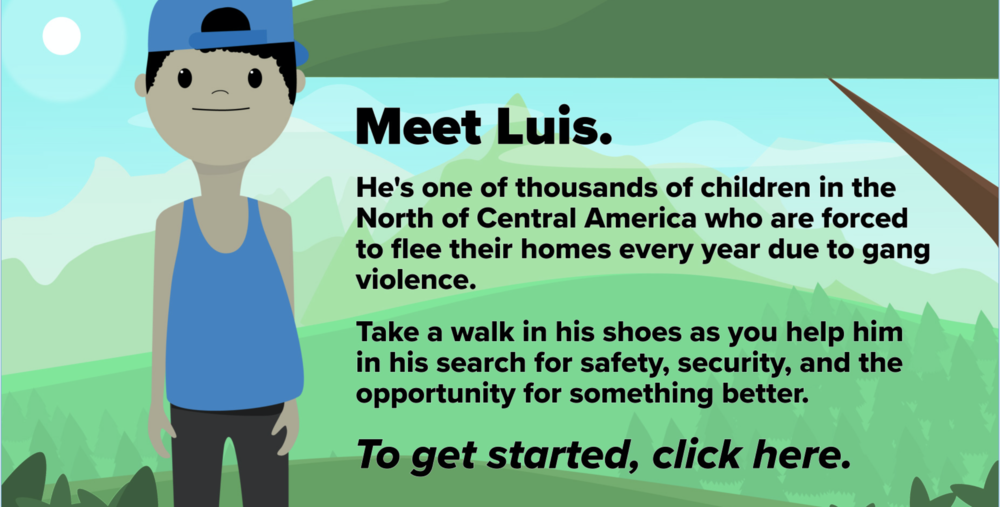Gamifying development - putting the shoe on someone else's foot
Gamification is all around us, capturing our attention in our online and offline experiences. We are constantly ‘unlocking’ rewards or ‘leveling-up’ on anything from our exercise to our shopping to our travel.
Gamified communication products and approaches can attract audience attention through novel experiences. Engagement can be enhanced through rewards that encourage return-visits and interaction. New and existing audiences can be reached through creative products and channels that deliver messages in unique formats.
In humanitarian assistance and development, gamification offers the potential to deliver what are often complex and varied messages in fresh, interactive and powerful ways. It also allows people the opportunity to ‘live’ a situation that they may otherwise not be able to comprehend.
The plight of refugees – how do we make it ‘real’?
In 2018, UNHCR Canada applied gamification to build public awareness of the plight of refugees, specifically children, fleeing the North of Central America. Through a ‘choose-your-own-adventure’ style game called Children on the Run, UNHCR Canada encourages ‘players’ to contemplate the impossible decisions faced by those who no longer feel safe in their home country.
More than 294,000 asylum seekers and refugees from the North of Central America were registered globally at the end of 2017, an increase of 58% from 2016 and 16 times more than recorded at the end of 2011. Many of these people were women or children who were unaccompanied or had been separated from their families.
The Children on the Run experience invites the audience to decide what they would do when fleeing gang violence. The scene is set with an introduction to a family who find themselves in the cross-hairs of a violent gang. Faced with a series of questions, the audience moves through the ‘game’ clicking the actions they would take if faced with a series of life-threatening scenarios, such as:
Would you beat up an old man to prove your loyalty and prevent harm to your family?
Would you encourage your children to flee or know they will be harmed if they remain?
Would you hand the small amount of money you possess before crossing the border to prevent your sister’s rape?
Misconceptions about why people leave their homelands are prevalent and UNHCR Canada Protection Officer, Azadeh Tamjeedi, explained why the organisation chose a game as a means of addressing some of these misconceptions.
“Often by stepping into the shoes of another person and trying to make the difficult decisions that they are faced with you have a better understanding of their story. We thought that this medium would create empathy and better understanding of what many of these children from the North of Central America go through on a daily basis,” Azadeh said.
Awareness, empathy and action through a game
UNHCR Canada commissioned Ripple Creative Strategy to develop the Children on the Run game as a means of increasing the profile and public understanding of refugee issues.
Ripple Creative President, Chris Stevenson, explained the intention of the game was to create an interactive experience, one that would ‘build awareness, empathy and action’ from the intended audience.
“The user follows Luis, Clara, and their family as they face the threat of gang violence and (the users) are put in the position of having to make the same impossible choices faced by thousands of refugees every year.”
Successfully communicating international aid and development issues requires doing through so in a way that people engage in issues that are often very literally foreign to them – in both a geographical and a lived-experience sense. As Chris noted, this requires inventive means of communications that ‘contain an emotive narrative’.
“In this particular case, we thought the ability for our intended audiences to "walk in the shoes" of our characters (Luis and Clara - based on a composite of real-life experiences provided to us by UNHCR) would be powerful,” Chris said.
Chis acknowledged the foresight and willingness of UNHCR Canada to experiment with a new product.
“We were fortunate to have a client that was willing to take this journey with us and to commit to the creative strategy we proposed,” Chris said.
The story of Luis and Clara’s story and the ability to interactively engage with it resulted in significant exposure for UNHCR Canada and the advocacy work they do on child refugee issues.
“We've had a very strong and positive response. One positive surprise was the interest of media. The CBC (Canada's national news broadcaster), took great interest in the innovative and creative way in which the story was presented. Likewise, various other UNHCR offices around the world picked up on the project and sought to promote or participate in the project,” Chris recounted.
Azadeh reported that the story of Luis and Clara made an impression on many Canadians.
The biggest surprise for users was the stories of the children from the NCA, many Canadians are unaware of the situation and I think that is what shocked them the most.
With this increased public awareness of the plight of refugees, comes confirmation that creative, innovative communications can increase understanding and empathy - critical elements to better communicating work undertaken in the the humanitarian and development sector.



